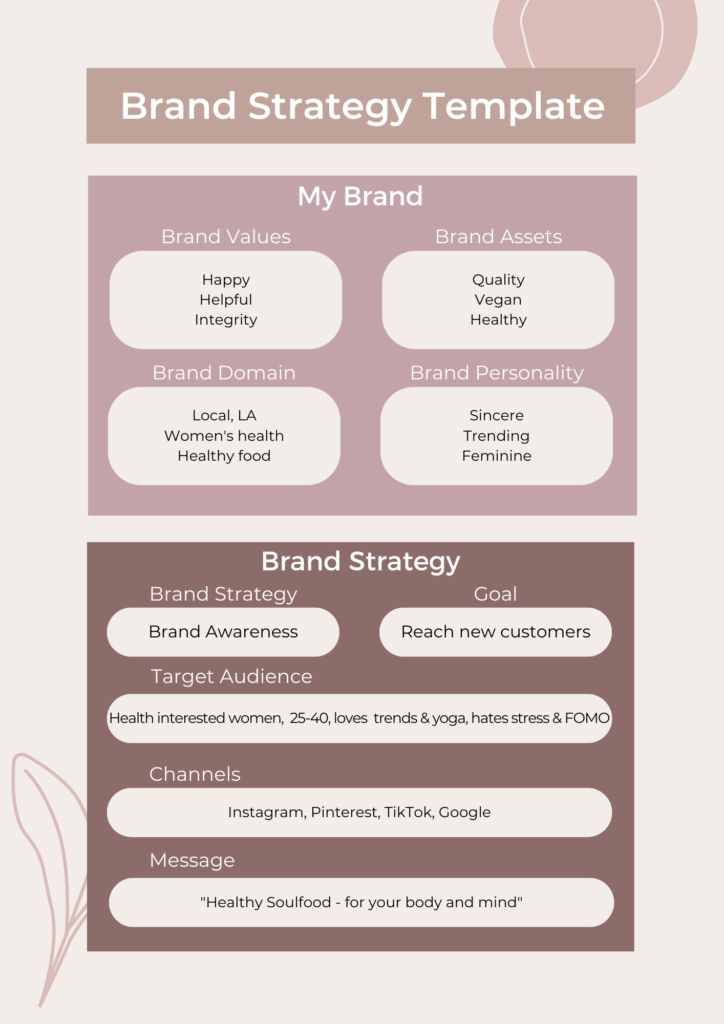Free Brand Strategy Template to Skyrocket your Brand Growth

Get a brand strategy template that helps build your brand and reach new customers. Use the free brand strategy template, included in this article, to create a brand strategy for your small business.
How do you write a brand strategy?
You write a brand strategy by defining your brand, choosing your goal and outlining the target audience, channels and message for your brand.
Use my free brand strategy template to write your brand strategy.
Keep reading this article to learn how to use the brand strategy template and create a brand strategy that will meet your goals.
In addition to a free brand strategy template, this article includes:
What is a brand strategy?
Before using the brand strategy template, you need to understand what a brand strategy is. And how to create a brand strategy for your business and brand.
A brand strategy is a plan to achieve the long-term goals of your business through branding. It is the way you communicate your brand to potential customers to gain traction and grow your brand.
It is important to note the difference between creating your brand and developing your brand strategy.
Creating a brand means to choose a brand name, create a graphic profile and developing the four brand dimensions. These are the values, assets, domain and personality of your brand. Your brand needs to be defined clearly before you create the brand strategy. If you haven’t created your brand, follow the 3 steps in this article on How to Build a Brand. In it you will get a step-by-step guide on what you need to do to develop your brand.
When you have created your brand, you can develop your brand strategy. The brand strategy means how you are going to communicate your brand. How you are going to build the brand in the minds of your potential customers. In other words, how you will reach these customers and ensure they know what your brand is and what it stands for.
Why a brand strategy is important
So you have created a brand, isn’t that enough? Can’t you just start communicating it?
You could, but it would not be very effective.
To get the most out of your branding, you need a clear strategy for reaching your goals. Depending on what business you have and how established the business is you will need different strategies on how to grow your brand. A brand strategy helps you define the goals you have for your brand. It also helps you form a clear plan on how you are going to reach those goals.
Branding is a long-term game and you need to have a plan on how you are going to grow your brand during the course of many years. It may seem daunting to start and that is why you need to break down your branding into a brand strategy. That way you will make sure you are taking the right steps at the right time to communicate your brand. It will ultimately help you reach more customers and develop long lasting relationships.
Types of brand strategies
The goal with branding is not to increase sales directly. That is the goal of promotions. Branding aims to develop awareness of your business as well as build meaningful relationships with your customers.
But depending on where you are on your branding journey, you need different strategies to target the right goals. There are three parts of brand building that we can break down into brand strategies:
- Brand awareness
- Brand image
- Brand loyalty
Let’s dive into how to create a strategy for each one of these.
Brand awareness strategy
When you are first starting out, no one will know about your business or your brand. That is when you need to start building brand awareness.
Brand awareness means how many people are aware that your brand exists. When building brand awareness your goal is to get people to recognize your brand and your offer. Meaning what product or service you sell.
The first step of brand awareness is recognition. This means that the consumer recognizes your brand when they see it. If you sell hair products it means that if they walk into a store and see your product on the shelf. They recognize it and remember that they have seen it before.
The second step of brand awareness is recall. That means that the consumer can recall your brand when they think about the category you are in. Again, if you sell hair products and the consumer was asked to name the hair product brands they know – they would be able to recall your brand.
Brand awareness is an automatic behavior for the consumer. Therefore, you need to reinforce this automatic behavior in your market communications.
Tactics to create brand awareness are:
- Exposing the product clearly. You need to put your brand in the right context meaning that if you sell hair products they should appear in your communications in a clear way. It should be obvious what you sell.
- Consistently exposing your brand. Because brand awareness is automatic, you need to be consistent in how you portray your brand. You should not change the way your product is exposed but rather keep the same communications. And, instead, expose the consumer of the same communications several times.
- Short contact time. To achieve brand awareness, especially recognition, the consumer does not need to see your brand for a long time. A few seconds is enough for them to remember your brand.
- Repeat exposure of brand. While the consumer does not need to see your brand for a long time. They do need to see it several times to remember it. Recognition is created after two repetitions of the same market communications. Recall takes longer and is created after being exposed to your brand several times in different contexts.
Brand awareness should be the first strategy you implement when you start building your brand. However, brand awareness does not measure whether consumers have positive or negative associations of your brand. It only involves being aware of your brand name and what your offer is.
That is why, after building awareness, you need to build a brand image.
Brand image strategy
Brand image regards the perception consumers have about your brand. It means the specific associations to your brand that exists in the minds of consumers.
After you have created some brand awareness you need to create a brand image. The brand image is important for consumers to be able to recognize the difference between your brand and competing brands. Creating a brand image involves creating associations to your brand. That is why brand image sometimes is named brand associations.
To create a brand image you need to create three types of associations; strong, favorable and unique.
Strong associations
Strong associations means that your brand needs to be strongly connected to the four brand dimensions. Again your brand dimensions are your values, assets, domain and personality. To create strong associations to your brand dimensions you need to be consistent and relevant in your communication.
Favorable associations
Favorable associations means that your brand needs to be desirable for consumers, and that you deliver on those desires. To create favorable associations you need to address your target audience’s pain points and needs in communications. Show how your brand will solve their problems and make their lives better. Learn more about how to find those needs in this article about the consumer decision making process.
Unique associations
Unique associations means that the associations connected to your brand should be unique. Because this makes consumers distinguish your brand image from other brands. Create unique associations by distinguishing your brand with a unique brand identity. This means the graphic profile and tangible elements of your brand. For example choosing a signifying color that stands out from competing brands. Unique associations is also created by differentiating your brand with the four brand dimensions.
By building a brand image you will create positive associations with your brand. These associations then creates a memorable relationship in the minds of your consumers. Once you have both brand awareness and a brand image you will grow your customer base immensely.
Brand loyalty strategy
Brand loyalty is about creating a customer base that continuously buys from you. Once you have built up brand awareness and a brand image you want to make sure that your customers buys from you time and time again.
While many might believe that brand loyalty means that your customers only buys your products, and not any competing brands, that’s not true.
There are very few consumers that only buys from one single brand in a category. Think about the apparel industry. You won’t find any consumers only buying from one clothing brand. But they will have their favorite brands that they always go to when looking to buy new clothes.
Therefore, brand loyalty is not so much about building a loyal customer base. Instead, your goal with brand loyalty is to retain customers. Thereby, increasing the amount of repeat purchases from customers.
Three tactics for brand loyalty:
- Remind your customers of your brands existence. In a world full of brands and ads, you need to keep reminding your customers that you are there. This means frequent communications with your customers through email marketing, social media etc.
- Engage your customer. You want to make your customers engage with your brand through social media. Create engaging content to keep your customers involved with your brand. You can read more about how to engage your customers in this article about Social Media Engagement Posts.
- To keep customers buying from your brand, you need to promote your product or service. Create sales promotion campaigns to increase customer retention.
With these three tactics you can build brand loyalty and ensure that you retain your current customers.
With that said brand loyalty should not be the only strategy you have. You always want to reach new customers and increase your customer base. If you have a brand known all over the world, like Coca-Cola, you don’t have to have a brand awareness strategy. But if you are a small business, you will need to keep your brand awareness strategy. Then add a brand image strategy and brand loyalty strategy as you grow.
How to use the brand strategy template
Now that you know how to build a brand strategy, we can get into how to use the brand strategy template.
The brand strategy template consists of two parts; your brand foundation and the brand strategy.
The brand foundation aims to help you remember your brand dimensions. It ensures that you use the unique characteristics of your brand in your brand strategy. Therefore, I have built in the four brand dimensions for you to fill in.
The second part of the brand strategy template is where you fill in your brand strategy.
You choose what type of brand strategy and fill in your main goal. Then you fill in the target audience for your brand strategy. And what channels you are going to use for the communications with your target audience. Finally, you fill in the message that you want to communicate in your brand strategy campaign.
Brand Strategy Template Example
To make it easier for you to understand each part of the brand strategy template, I have created an example. I have filled in the brand strategy template with a made up vegan health café in Los Angeles; Healthy Soulfood. Since the strategy is for brand awareness, I have created a message that can be repeated in communications, almost like a slogan. This message would be used in all communications with the target audience, in all channels. That way the brand is exposed clearly, consistently and with repeated exposure. It also makes sure that the contact time does not have to be long. This will maximize recognition and recall for all potential customers.

By now you should have every tool and resource you need to complete the brand strategy template. And create an amazing brand strategy for your business.
You can download the brand strategy template below:
If you enjoyed this article and found it helpful, make sure to check out the similar articles linked below. And share it with a friend or coworker you think could benefit from it!

I'm Emma Ellinor
I’m a digital marketer, project manager and retail analyst.
For the past 7 years I have immersed myself into the field of marketing and management. I am on a mission to inspire more women to take their business to the next level. By sharing my journey to escape the 9-5 trap along with useful marketing, time management and small business tips.
